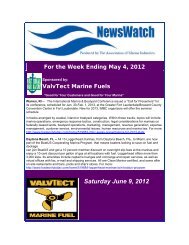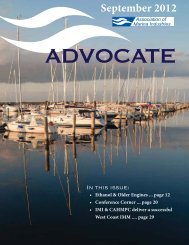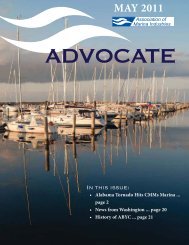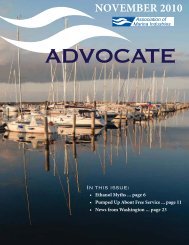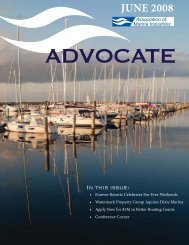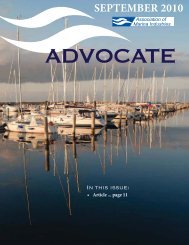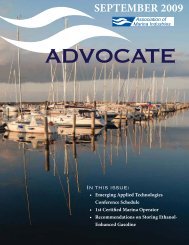Entire Document - California Department of Boating and Waterways ...
Entire Document - California Department of Boating and Waterways ...
Entire Document - California Department of Boating and Waterways ...
Create successful ePaper yourself
Turn your PDF publications into a flip-book with our unique Google optimized e-Paper software.
The more critical situation typically occurs during low water periods (i.e. low tide)when the relative position <strong>of</strong> the lower end <strong>of</strong> a gangway is closer to the edge <strong>of</strong> afloating dock. If it is necessary to have a gangway “l<strong>and</strong>” near the edge <strong>of</strong> a floatingdock, supplementary flotation may be necessary under the edge <strong>of</strong> the dock belowwhere the gangway rests. This extra flotation might be necessary to maintain safe<strong>and</strong> required freeboard levels <strong>and</strong> cross slopes under various loading conditions.Full LL on a gangway probably will not occur very <strong>of</strong>ten. Therefore, to transfer thefull gangway structural design ULL <strong>of</strong> 50#/ft 2 to the gangway-supporting dockswould result in “unloaded” docks that ride unnecessarily high in the water for longperiods <strong>of</strong> time, causing excess dock freeboard. This causes localized differences infreeboard <strong>and</strong> problems with cross-slopes, especially along those areas that arepart <strong>of</strong> an accessible route.The above reduction provides a reasonable consideration <strong>of</strong> both typical <strong>and</strong>extreme conditions without compromising safety. In the event that a gangway wasloaded with the full design ULL <strong>of</strong> 50#/ft 2 , this short-term load would spread withinthe dock system. Freeboard would diminish, pontoons would be forced deeper intothe water, <strong>and</strong> the dock’s structural frame would cause the load to spread to othernearby pontoons that would pick up portions <strong>of</strong> the gangway load. Any welldesigned<strong>and</strong> constructed dock system should be capable <strong>of</strong> supporting additionalshort-term loads that temporarily reduce the design freeboard. Once the higher thannormal loads are removed, the dock recovers <strong>and</strong> freeboard returns to normallevels. This dynamic action described above can only be tolerated if the minimumfreeboard requirements for floating docks are still complied with.......................................................................F2.5 Minimum Clear Width <strong>of</strong> GangwaysCommentary:Nominal widths <strong>of</strong> gangways typically vary from 36 to 60 inches, depending onlocation, expected traffic loads, gangway lengths <strong>and</strong> special needs.If gangways are too narrow, they can be awkward to use, <strong>and</strong> people moving up<strong>and</strong> down a gangway at the same time cannot pass safely <strong>and</strong> comfortably,particularly during low water periods when gangway slopes are greatest.Conversely, if gangways are too wide, the h<strong>and</strong>rails on each side cannot be used atthe same time if desired <strong>and</strong> needed. This is important to people with small children,senior citizens, persons with disabilities, etc.Considering the requirements for 1¼ to 1½ inch h<strong>and</strong>rail diameters, 1½ inchclearance between the h<strong>and</strong>rail <strong>and</strong> the gangway railing posts or other supportingelements, the 36 inch minimum clear width, <strong>and</strong> the width <strong>of</strong> the railing structure,the total overall minimum width <strong>of</strong> an accessible gangway will be about 48 inches.Appendix A -- Section F Commentary - Page 114



